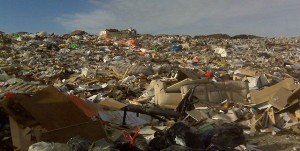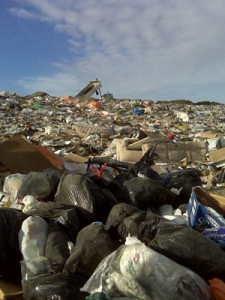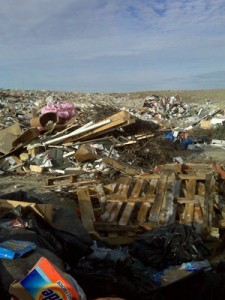Since I am a renovator, I am obliged to haul demolition and construction debris to the dump from time to time. I expect this gives me a somewhat different perspective on this topic than folks who don’t make that trek on a regular basis. Nearly every time I go I am directed to unload at a different geographical location within the dump site. This means that the last place where I unloaded is now full and a new area has been designated.
(Aside: I do prefer the term “dump” over “landfill”, by the way. I think the term “landfill” was coined to disconnect us from the real nature of what is happening. Language is so tightly connected with the way in which we perceive things, that changing a word can change our thoughts about the thing that the word represents. “Landfill” sounds so benevolent doesn’t it? Like we’re doing our part for the greater good by filling holes that have somehow opened up in the landscape, presenting and clear and present danger to wildlife… “Dump” is so crass…)
 The way a large dump works is that an area is designated as the current dumping spot. Once that area is filled, a new area is designated for that purpose. While dumping proceeds in the new area, the old area is crushed down with heavy machinery and then covered over with dirt to prepare a new platform for receiving more detritus. There may be a series of different designated areas, but eventually you end up coming back around to the first place. And so it goes, adding layer upon layer upon layer of detritus, each cycle making the mound higher, like an enormous pyramid of filth — an immense and near-permanent monument to our excess and carelessness.
The way a large dump works is that an area is designated as the current dumping spot. Once that area is filled, a new area is designated for that purpose. While dumping proceeds in the new area, the old area is crushed down with heavy machinery and then covered over with dirt to prepare a new platform for receiving more detritus. There may be a series of different designated areas, but eventually you end up coming back around to the first place. And so it goes, adding layer upon layer upon layer of detritus, each cycle making the mound higher, like an enormous pyramid of filth — an immense and near-permanent monument to our excess and carelessness.
By my tone, I’m sure you’ve identified that I don’t like having to go to the dump. I dread it, in fact. I, like most, would prefer simply not to see it or think about it — set my garbage bags in the back alley on Wednesday night and wait for the garbage fairies to magically disappear them in the morning, so that I can start filling new bags for next week. This is, of course, just one more example of our disconnection to or willing unawareness of the working mechanics of the society in which we live. Out of sight, out of mind. If we do not see the effects of what we are doing, we are less inclined to think about those effects and we are then able to focus on the pursuits of our own life without having to think too hard about its impact on other things. This “disconnected-ness” is the same phenomenon that has left most of us without an understanding or appreciation of how the meat in our supermarkets arrives there so neatly packaged and free of conscience-affecting icky-ness. If we saw the slaughter or were responsible for it ourselves, we would almost certainly have a greater awareness of our personal impacts on the world around us, and might make different decisions about how or what we eat, or how what we eat is treated. I watched a documentary once that showed piglets being castrated using a pair of pliers, their testicles simply ripped out of them without even the benefit of anaesthetic. It was horrific. That one image hasn’t changed my eating habits, but it has given me more awareness of what goes on and therefore more informational context within which I can make my decisions. If I were to see more of that kind of thing I would be likely to make more drastic changes to my eating habits. But here I expose my hypocrisy: I don’t want to see more things like that, so I don’t seek them out. I don’t want to consider the wholesale kinds of changes that I would have to make to my life in order to not cause piglets to have their testicles ripped off on my behalf. Do you realize how many delicious meat products have pork in them? I don’t watch it. I don’t fill my head with grotesque images. And therefore, I don’t have to think about it when I’m salivating over freshly fried bacon. Mmmm mmm. But I digress…
 The reason I dread going to the dump is that (unlike my ability to not watch graphic documentaries about the food industry) it is at the dump that I come unavoidably face to face with the tangible consequences of the way we live. When I am there, it is absolutely impossible to not think about the massive footprint we are leaving on the face of the planet — and the fact that I am there precisely to do my little part to make that footprint just a bit bigger. At the dump I cannot be willfully blind no matter how I try.
The reason I dread going to the dump is that (unlike my ability to not watch graphic documentaries about the food industry) it is at the dump that I come unavoidably face to face with the tangible consequences of the way we live. When I am there, it is absolutely impossible to not think about the massive footprint we are leaving on the face of the planet — and the fact that I am there precisely to do my little part to make that footprint just a bit bigger. At the dump I cannot be willfully blind no matter how I try.
So what is the purpose of all of this rambling of mine? Is it to make us feel bad? It may have that effect, but that is not the goal, no. The goal is to create awareness, and to nurture a mindset that looks just a little deeper at the way we are doing things. Because the waste that we generate is not good, and things need to change. The dump is the tail end of a conveyor belt that begins at consumer demand. In order to reduce materials going into the dump, we need to reduce the number of things we consume. The math is simple. But the devil is in the details. Future posts will delve more into this.

ok, now the visual of the piglet thing has been seared in my brain’s image folder…
the dump…the locals up north who come home with more than they took call it Walmart tee hee
I have grown a new respect for people who pillage the dump. I used to think this represented a cheapness on the part of those people, but now I see it differently. Kudos to them for doing their part, no matter what the underlying reason.